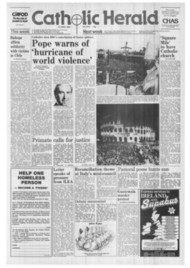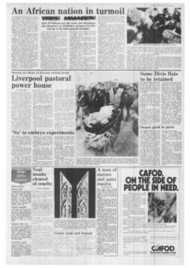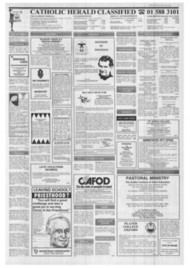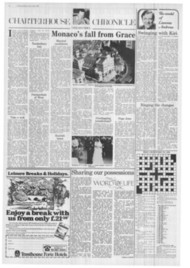Page 11, 12th April 1985
Page 11

Report an error
Noticed an error on this page?If you've noticed an error in this article please click here to report it.
Tags
Share
Related articles
The Frustration Of Princess Grace
World Pays Tribute To
The Pope Blesses The Baby
Monaco’s New Ruler Enthroned At Mass
Monaco's fall from Grace
IHAD OCCASION before Easter to spend a few days in Monaco and was much moved while pausing, on the twisting road above Monte Carlo, at the spot, on a terrifying hairpin bend, where Princess Grace's car shot off the road and caused her instantaneous death.
The speed with which the Monagasque police and ambulance corps were on the spot (in French territory) was long a bone of contention between Monaco and France.
Suffice it to say that Monaco has never been the same since Princess Grace died. She gave it an ethereal sense of beauty and purity which its present atmosphere of apparent obsession with Mammon has obliterated.
Feverish attempts to build on every availablesqUare inch of ground — to say nothing of land constantly being "reclaimed" front the sea — make the doings of the former gamblers and aristocratic playboys seem like children's games by comparison.
What a pity that, in the porch of Monaco's nineteenth-century Cathedral, despite a notice referrring to the "tomb" of the Princess, she is buried under a plain slab behind the High Altar.
A more imaginative monument would surely have been in order, if only to redress the drabness of a Cathedral which is not improved by the officious behaviour of its guardians. One of these, smelling strongly of drink at eleven in the morning, shouted at anyone who dared to stray into some forbidden corner of the building.
It was with obvious relief that most of the visitors went out to look at the charming buildings of Monaco's nearby "old quarter" and/or to visit the fascinating Museum of Oceanography not far away.
Take a wok
I have received a card saying "Please come to a Chinese Cookery Demonstration by the Famous Yan-Kit So" at Church House, Holy Trinity, Brompton Road, London SW1, at 11.30 a.m. on Wednesday, April 17. Tickets, which will include as much of the delicious delicacies as one can consume, will cost £9.50 but all proceeds will be in aid of the Hospital of St John and St Elizabeth and Gainsborough's House Museum.
The former is well-known to most readers. The latter, well signposted in the middle of Sudbury, Suffolk, where Gainsborough was born (about £5 day return from London) has become a popular spot to visit, with continual exhibitions of interest, but heavily dependent on the generosity of appreciative individuals.
I am an ignoramus on the subject of art but fascinated by what made our classic artists tick. What a great man Gainsborough was, if only because he cared so little for the esteem of the snobs and "experts" of his day as to withdraw from the Royal Academy.
As a shrine to the genius who dared to be different, his housecum-museum in Sudbury will surely appeal, as a good cause, to mavericks manques of modern times.
Tewkesbury loss
NO NEWS I fear about the priceless statuette stolen from Tewkesbury Abbey, hut I have had an interesting letter from its vicar (Tewkesbury not being a Cathedral but an Abbey-parish church).
His parishioners, he tells me, feel that the very thick glass formerly protecting the statue should be left in its shattered state to draw the attention of visitors to the site of the theft, a notice about which is still on display outside the main door.
How the thieves managed, within a few minutes, to break the bullet-proof glass remains a mystery. But one can only hope that summer visitors to this particularly beautiful Abbey, which is far from rich, will be even more generous than ever in the offerings they leave behind.
This will be some recompense to the devoted band of men and women who look after the Abbey which can obviously not afford the elaborate security arrangements normally more appropriate in a bank.
Patriarchate of West
LAST WEEK'S reference to Catholic Copts prompted comment and enquiries about this and other "Uniate" churches, that is churches akin to Orthodoxy in using Eastern Rites but full members of the Catholic Church in being subject to the Pope's jurisdiction.
They are collectively known as the Eastern Catholic Churches and their parent bodies, as it were, are the ancient patriarchates of the East, Alexandria, Antioch, Jerusalem and Constantinople, rather than the only Patriarchate of the West, namely Rome.
They have had a chequered and troubled history with many unfortunate clashes with the Greek and Russian Orthodox Churches when they decided to "return" to allegiance to Rome. Their status was given definitive form by Vatican 11's Decree on the Eastern Catholic Churches.
Left undisturbed was the legislation which permits Eastern Catholic priests to be married. Pictured here, through the kindness of an Oxford reader, is Father Laszlo Dudas of the church of Mariapocs in the Greek Catholic Diocese of Hajdurog (South Eastern Hungary) on his wedding day.
There are, however, certain "snags", if that is the right word. It all goes back to the 692 Synod of Trull° (still in force) whereby candidates for holy orders may marry before ordination and remain married thereafter. Marriage, however, is forbidden after ordination, and Eastern-Rite bishops must be celibate.
Married candidates
I HAVE noticed that, in the United States, Eastern-Rite bishops rarely, if ever, accept married candidates for the priesthood. This practice has been criticised in view of the cases, admittedly exceptional, where married men have been ordained as priests in the Latin (Western) Rite.
The interesting fact remains that in the Catholic East there is no shortage of aspirants for the (mostly married) clergy while, in the West, where celibacy is the rule, vocations have, in general, fallen off disastrously.
At long last, moreover, relations between Orthodox and Eastern Catholic Churches have greatly improved. The church, in fact, where Fr Laszlo Dudes was married, ordained and now serves, combines the features of East and West. The pulpit, pews and pictures are in Western Renaissance style, while the iconostasis which conceals the High Altar is Orthodox in character.
The church is a local beauty spot and is famous for its ikon of Our Lady which eye witnesses have sworn to see shedding tears on certain occasions. The first reported case was in 1696. The last in 1905. It became well known as the Pious Ikon of Mariapocs and the church was given the status of a Minor Basilica by Pius XII in 1945.
With Catholics and Anglicans now so eagerly and continually pursuing ecumenical dialogue with Orthodoxy, there is increased interest in the "uniate" formula, in its broadest and best sense, as the basis for ultimate unity (without uniformity).
In the more limited area of Anglican-Roman Catholic relations, this formula did not seem, in the days of Pope Paul, an impossibly distant solution. Today it seems more like a faded dream. Greater understanding of Eastern traditions, and a shedding of automatic prejudice, for example, against the principle of married priests, may help to revive it.
Kentish times
NEXT MONDAY will see the publication of a book called The Keats by Audrey Whiting (Hutchinson). The author is described as "one of Fleet Street's most distinguished commentators on the British royal family" but the chapter on Princess Michael of Kent fails to come to life as much as other parts of the book. This may be because she did not, apparently, consult Prince and Princess Michael about what she was going to write.
The Princess's step-brother is not called Mario (p. 195) but Matthias. An interview of some importance elven by Princess
Michael is quoted at some length (pp. 203-5) hut the magazine in which the interview appeared was not called Royalty, as stated, but Majesty.
Comparatively small points admittedly. More importantly, perhaps, Prince Michael did not, strictly speaking, (p. 197) "giveup his rights to the throne" by marrying a Catholic. This was an automatic consequence of the Act of Succession and if that Act were to be repealed, his rights would be just as automatically restored.
The author, however, is generous about the Princess's qualities and refers to the resolution of the religious tangle surrounding her marriage to, Prince Michael.
A Catholic church wedding had not been possible in 1978 since Pope Paul VI had withheld the necessary dispensation for a mixed marriage in the absense of any undertaking that the children would be brought up as Catholics.
There could be no alternative in the form of an Anglican wedding because of the Princess's previous marriage, whose annulment was not recognised canonically by the Church of England.
Five years later there was a change of mind in Rome and the couple were married with a full Catholic ceremony in the private chapel of Archbishop's House, Westminster, in July 1983. "The couple," the book adds, "brought up their children as Anglicans, and as regular churchgoers continued to attend a Church of England service one week and a Roman Catholic service the next."
All right as coffee-table history — strictly instant.
Overlapping jurisdictions?
THERESA HYNES, in a letter to the paper, has put her finger on a sore but interesting point in questioning whether Archbishop Bruno Heim is Apostolic ProNuncio to the United Kingdom or Britain and Northern Ireland. He is. That is his official title. But it is also true that when this appointment was made, it caused some misgivings about the position of the Papal Nuncio in Dublin. The problem was overcome, after a fashion, by stressing that the Dublin Nuncio still had jurisdiction over the whole of an Ireland that was united religiously but not politically.
There are naturally, however, those who do not find this "solution" wholly logical or convincing. It is one of the many anomalies yet to be ironed out with regard to the eternal and ever more tragic "problems" of Northern Ireland.
Pope Joan
IN VIEW of the interest expressed by several readers in Joan Morris's book Pope John VIII an English Woman. Alias Pope Joan, may I, with apologies, correct my mistake in wrongly giving the address of the publishers, Messrs Vrai, as 27 Red Lion Square, I.ondon WD1R 4PS — when I should have written Red Lion Street.
I AM sorry in retrospect that, in writing about Mount Saint Bernard, I dropped, for lack of space, my originally intended reference to Ambrose de Lisle, the great layman who funded the Abbey's foundation. It would have been tempting. I thought, to go on for too long about the man to whom, as I had started to write, the Welds of Lul■vorth "later passed the torch." The inadvertent distortion which resulted was caused by what Bernard Shaw called "the curse of careless cutting."
The fact of the matter is that Ambrose de Lisle deserves a whole article to himself which, alas, would not have been possible on this occasion.
blog comments powered by Disqus












